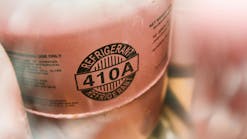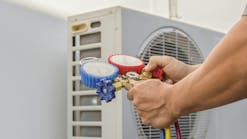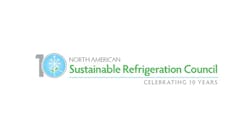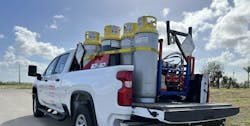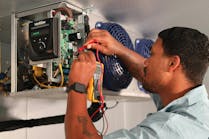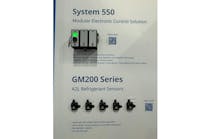The use of variable-frequency drives (VFDs) in supermarkets to control compressor and fan motors has become a key factor in reducing energy costs, enhancing product life and salability, and improving equipment service life. For outdoor condensers, drives using variable-speed have made important contributions to noise abatement.
Load Conditions
Refrigeration systems are designed for full-load conditions. Most of the time, however, their loads are average, not peak, and full motor capacity isn’t required. During average conditions, motors in traditionally designed systems (without VFDs) are either constantly running at a higher speed than necessary, or frequently cycling on and off. Producing more capacity than needed wastes considerable energy, and frequent on/off cycling accelerates wear and shortens the useful life of motors, contactors, and other components. Frequently starting and stopping motors and continually accelerating them to full speed eliminates opportunities for reducing energy costs. VFDs can help in both of these areas as well as provide better product environments.
Although maximum-load conditions — high ambient temperature, high humidity, and fully loaded store fixtures and storage boxes — exist as little as 4 percent of running time, refrigeration systems must be designed to cope with them. However, it is just as desirable for systems to provide as much of the required capacity for expected part-load conditions as possible. Unfortunately, providing capacity to meet peak demands wastes considerable energy when part-load conditions exist, if machines simply are switched on and off.
Advances in Supermarket Refrigeration
During the 1980s, many supermarket installations had one condensing unit for each circuit, and each condensing unit had a single compressor. Control was provided by the same type of low-pressure switch found today (often as backup for microprocessor control). There were two major problems with these kinds of systems: A lot of cycling occurred, and, when a compressor broke down, the circuit was left without refrigeration.
Strategies first began to improve with the advent of twin-compressor systems. These delivered at full or half capacity, and there were fewer, although still significant, cycling problems under light-load conditions. Product losses caused by failed compressors lessened considerably. With the arrival of three-compressor racks, compressors used in conjunction most often were of equal capacity (such as three, 10-hp compressors), delivering four capacities to circuits. Multiple circuits often were served by one rack. For example, three 10-hp compressors had four capacities of 0-, 10-, 20-, or 30-hp. Designers also built racks with unequal-sized compressors using, for example, one 10-hp and two 20-hp units to deliver 0-, 10-, 20-, 30-, 40-, or 50-hp in various combinations. Quadruple racks with four compressors that offered 10-hp or more capacities, depending on the size of the available compressors, followed. Control of uneven parallel racks presented a complex engineering challenge that, beginning in the 1980s, was met by the application of microprocessor controllers with software that has continued to grow in sophistication and capability. Stable, reliable sensors now provide control-system software with temperature and pressure information for accurate, repeatable control.
The larger the number of capacity steps available to a refrigeration system, the closer the system can match changing load. Using only needed capacity saves considerable energy. The application of a single VFD on a refrigeration rack can vary the speed and, therefore, the capacity of a compressor from zero (off) to as much as 150% of nominal speed because the drive effectively can supply up to 90 hz (150% of rated current frequency), provided the compressor for which the drive is installed is inverter-rated up to 90 hz. Therefore, the capacity supplied by the compressor is about 50% greater than nominal capacity.
Variable Speed Benefits
In today's supermarkets, VFDs commonly are applied to regulate the operation of remote condenser fans and, to a lesser but growing extent, air-handler motors and HVAC fans.
In addition to providing constant load-matching capacity and saving energy by eliminating over-capacity running, variable-speed operation can result in substantial maintenance savings and enhanced compressor and fan-motor lifetimes. Variable speed also solves the noise-abatement problem for condenser fans.
It's important to use inverter-rated motors when specifying variable-speed installations. In retrofitting VFDs to existing installations, it's important to work with a qualified vendor who can fit existing motors with appropriate filtering.
Max Robinson is a freelance writer for Danfoss.
VS Motors: Reduced Noise, Energy Savings
Variable speed condenser fan motors have several advantages when compared to fixed speed motors, including reduced noise in part load operation, improved head pressure control, and energy savings, says Ira Richter, of the research and development department of Heatcraft Refrigeration Products (HRP).
HRP's variable speed electronically commutated fan motor (VSEC) is combined with the Orbus controller to maintain head pressure control. When the head pressure falls below the set point, the Orbus controller reduces the fan speed to maintain the desired set point, Richter explains.
"The reduction in fan speed results in lower operating noise under reduced condenser load. The fan motor can operate at an infinite number of speeds, to exactly match the condenser capacity to the required load, to maintain desired head pressure," Richter says. "Contrast this to a fixed-speed fan motor, which only has two capacity levels: off (or 0% capacity) and on (100% capacity), and must rely on fan cycling to control head pressure. The variable speed fan provides precision head pressure control, eliminating the need for fan cycling."
Variable Speed Becomes a Customized Service
For the past year, Sam Wilson and his 12-technician team at Refrigeration Solutions, Inc. (RSI) of Sacramento, CA, have been building customized variable speed racks for use in medium-size supermarkets.
RSI is a refrigeration service and installation business, specializing in commercial and industrial Design/Build refrigeration projects, including compressor racks, cold and frozen storage, and meat, produce, and production facilities.
"There's nothing cookie-cutter about it," he says. "Every rack and refrigeration system is custom-engineered. The programs are also customized for what the customer needs. Each control panel is built for that specific customer, with their name on it. The sky's the limit on what we can offer. The energy savings has been great. We try to control temperature with saturated suction temp as much as possible. But, you can’t have everything in the same group exactly alike, so we also use sensor and solenoid."
Wilson has been in the industry for 30 years, as a field technician and project manager for Hill PHOENIX, and later with Hussmann. He started RSI in 2005.
"We started building racks just for our customers, but we've been getting requests from other contractors and store owners," Wilson says. "We analyze what we think will be the best system control-wise. Everything we do is variable speed."
Wilson says the custom-build service gives RSI the freedom to try different things every day. RSI's customized systems often consist of Yaskawa drives, Bitzer compressors painted in RSI’s signature blue, and Emerson Einstein controllers. — Terry McIver

